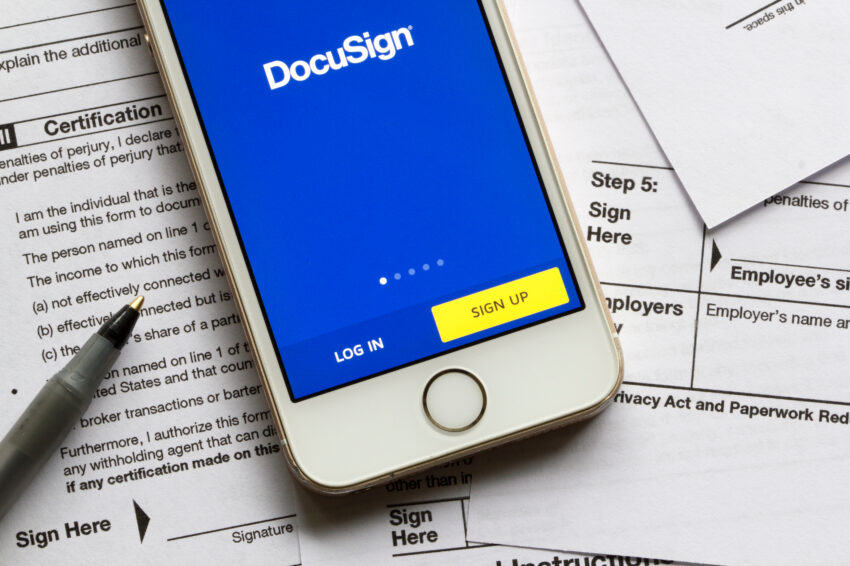Hybrid Working is reshaping not only the future of work but also the present. Ronan Copeland, GVP General Manager, EMEA, DocuSign explores how the right digital tools drive employees to create, innovate, and collaborate better.
No one can deny the last two years fundamentally changed the world of work. Offices and workspaces closed in favour of home working, forcing decision makers to not only ensure the right processes and protocols were in place, but that digital transformation strategies were re-evaluated and accelerated.
Such processes often resulted in ad hoc work models being created, but the latest findings from the Office for National Statistics report that during the last few months of 2021, output per hour overtook that of pre-pandemic levels for the first time, reenforcing that hybrid and remote working had an important role to play in business growth.
Now, as the world of work re-opens, organisations are actively looking at how hybrid working is forged by the anywhere economy, and digital tools such as e-signature and contract management can be incorporated into the “present” of work.
The Right Tools at the Right Time
Being able to do business and operate from anywhere is what people now expect, effectively creating the anywhere economy. As a result, it is understood that up to 85% of managers believe that having teams with remote or hybrid working will become the norm.
By deploying e-signatures, organisations not only offer flexible work practices, but can also readily replace old, manual, paper-based systems, while at the same time boosting productivity and freeing up teams to focus on growth.
However, working from anywhere is based on the proviso that the right digital processes, such as the use of e-signatures for the approval or consent on electronic forms or documents. Legally recognised, e-signatures represent the most practical, cost-effective, and legally valid way to complete transactions, sign business contracts to confirm invoices, and are even used as identity verification. It is no wonder that DocuSign eSignature has been used in more than 180 countries to create over one billion legally enforceable agreements.
Organisations accustomed to using paper documents often also do not understand the risk of sending confidential, often sensitive, information in a physical manner. Once sent, even by courier, there is no longer an overseen chain of control for the sender, they will not know who will have access to the document, handle, process or store it.
By contrast, e-signature delivers a secure digital workflow that ensures a clear and predictable process. Senders have complete visibility of the digital document from the moment it is sent and through its entire lifecycle. They can control access, thus maintaining security standards for the business.
Furthermore, when using e-signatures, an additional level of protection is inherently built into the signed document. This is accompanied by a digital audit trail, also known as a Certificate of Completion, which documents crucial information, such as date, timestamp, identity authentication and IP address. This amounts to a unique identification system that authenticates and provides a mechanism to counter a signer disputing their signature.
But for the most part, the only thing holding many companies back from adopting e-signatures is a lack of understanding how much faster, secure, and more sustainable they are than their physical counterparts. So much so, a DocuSign survey found that two-thirds of today’s e-signature users started using the technology in the last two years, and 88% state they have no plans to revert to pen and paper signings.
Smarter Ways of Working
There are many reasons why organisations switch to digital agreement processes beyond their value in remote working environments. From a wider perspective, e-signatures also offer benefits to the environment, helping to support an organisation’s sustainability aims. For example, since 2003, DocuSign and its customers together have saved more than 6 million trees, 55 billion sheets of paper, 22 billion litres of water and eliminated more than 2 billion kgs of waste – purely by adopting digital agreement processes.
Moving manual processes into the cloud is effective as it makes work processes faster, more secure, and more sustainable. Technologies such as Slack or Google Drive have streamlined collaboration and file sharing, while DocuSign CLM (contract lifecycle management) software seamlessly manages all of the agreements and documentation, allowing organisations to increase compliance, accelerate the pace of doing business, as well as eliminate unnecessary waste.
It achieves this by automating tasks, managing complex workflows, and even removing bottlenecks within the process chain to make the whole work more efficient. This increased oversight is created by standardising processes, saving the legal team time, driving business opportunities, and uncovering new trends.
The last two years have changed not only the future of work but also the present. Hybrid working has become the norm, supported by digital processes that support and drive the anywhere economy. To build on those experiences, organisations that want to thrive in the modern hybrid world must make e-signatures and complementary digital agreement technologies a permanent part of their overall strategy for success.


